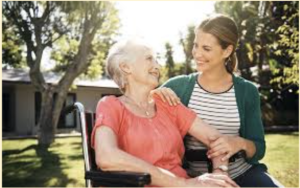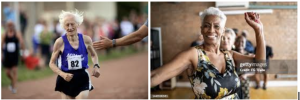6
Section One: The Fundamentals
A) Keywords
Exercise 1:
Provide a brief definition of one of the padlet keywords for this week.
| The anti-ageing agenda is the idea that physical activity is often promoted to the aging population as a way to prevent aging and stay young. Elizabeth Pike explains that this suggests that aging is something to be afraid of or to avoid, not something to be celebrated. It reminds me of our conversation about ableism, and how society often looks down on disabled people, similar to how society looks down on aging. |
B) The Social Significance of Aging in Sport
Exercise 2: Notebook Prompt
How is old age popularly represented today? Find an image online that you think exemplifies one defining attitude towards old age and paste in your notebook below with a brief explanation of what this image means to you.
I feel like today, old age is popularly represented as being helpless and fragile. Most of the time, when society thinks about old people, they think about how they are not independent and require the care of others who are younger and more capable. A lot of people feel bad for old people. For example, people often feel sad when they see an older person eating alone, but don’t think twice about a young person doing the same. I think there’s still a young versus old superiority complex in society today. This is reflected in the image I chose, as it shows the old lady as in a wheelchair, and reliant on the care of the younger lady, rather than being self-sufficient and independent. 
|
Exercise 3: Notebook Prompt
What does the article (referencing another study by Dionigi) mean by its statement that sport can help aging people to simultaneously “accept and resist the ageing process” (572)? Respond by audio or text and find paste two images sourced online into your notebook showing how sport might help aging people to both accept and resist the aging process.
The statement that sport can help aging people to simultaneously “accept and resist the ageing process” refers to the dual role that physical activity can play in later life. On one hand, engaging in sport allows older adults to accept certain limitations that come with age, such as reduced speed or strength, by staying active in ways that suit their changing bodies. For example, on the men’s rugby team for Barrie RFC, there is a man who is in his 60s and still playing rugby. He has switched positions from one that is very high contact to another that is less contact and mostly just running, as this better suits his body at this point. This may also look like trying forms of exercise that are more enjoyable, such as dancing, yoga, walking, etc. On the other hand, it also allows them to resist societal narratives that portray aging solely as a time of decline and dependency. This idea highlights how participation in sports can help aging individuals maintain a sense of identity, autonomy, and physical competence, even as the body ages. It becomes a way for older adults to challenge stereotypes about what aging looks like.

Exercise 4: Notebook Prompt
Who are the groups less likely to have extensive opportunities to take part in sports, according to Pike? How does privilege factor into aging and sport? (200 words max)
| According to Elizabeth Pike, groups less likely to have extensive opportunities to take part in sports include individuals with disabilities, those who are very frail, people living in rural areas, some minority ethnic groups, and those in care facilities. These populations often face structural and cultural barriers that limit access to sport and physical activity.
Privilege plays a significant role in shaping these opportunities. Those with greater access to economic and cultural capital, which typically include white, middle-class individuals, are more likely to have the resources, time, and encouragement to engage in sports in later life. Marginalized groups may lack appropriate facilities, role models, or supportive policies. Additionally, aging intersects with other forms of inequality, such as gender. For example, older women often face declining activity levels, partly due to societal expectations that they continue to serve as caregivers, which limits their time and opportunities for sport. |
Exercise 5: Padlet Discussion
Why do you think age discrimination is “reported more than any form of prejudice” with older people presented as a threat to social values and interests? Feel welcome to use video in your responses. Paste your comments (or transcript of your video) below!
| I think age discrimination is reported more than any other form of prejudice because it’s one of the few types of discrimination that nearly everyone will face, assuming they live long enough. Unlike race, gender, or other fixed identities, age affects all people over time. Due to this, ageism can feel more socially acceptable, as if it’s just a natural part of getting older rather than a harmful bias. It’s also more common because older people are often seen as less productive, out of touch, or even a burden on systems like healthcare. In a society that places heavy value on productivity, income, and innovation, older adults can be framed as a “threat” to progress. They’re often viewed as slowing things down, which is why we hear about older employees being pushed out of companies. I also think this stems from a fixed mindset in our culture, which is the belief that people only grow and improve up to a certain age. As a result, older adults are seen as “stuck” or no longer evolving, which leads to the assumption that they’re no longer worth investing in. |
B) Older Women and Sport
Exercise 6: Notebook Prompt
What differences do you see in these ads? Which one is more inclusive? How is age represented or not represented in each? Answer these questions in your notebook.
| In the first Nike ad, there is representation of people from different races, genders, sports, and abilities, but they are all young, fit, and high-performing athletes. Age is not broadly represented, as the athletes appear to be young, showing athleticism as something only associated with youth. The second ad, from the This Girl Can campaign, features all women of various ages, races, socioeconomic backgrounds, and lifestyles engaging in physical activity. While it doesn’t include men, it does a strong job of representing diversity within the category of “women,” especially in terms of age.
I think the second ad is more inclusive. It was designed to increase physical activity among women, and it includes a wide spectrum of experiences, not just those of elite athletes. It includes everyday women with real bodies and real lives. It acknowledges that sport and activity are for everyone, not just the young or the elite. |
Exercise 7: Notebook Prompt
In her article, “Assessing the sociology of sport: On age and ability,” Elizabeth Pike references a “trend towards a ‘feminisation of ageing’, with many women living longer than men” (573). Do you agree that aging has been “feminized” in this way? How? Answer these questions in your notebook.
| I do agree that aging has been “feminized” in the way Elizabeth Pike describes it. As Pike mentioned, more women live into old age than men, making aging a predominantly female experience. Socially, aging is often associated with traditionally feminine traits like self-care, health monitoring, and maintaining appearance. This creates pressure for older women to “age gracefully,” while older men are not held to the same standards. Additionally, aging women are more likely to be viewed as frail or invisible, while older men are often seen as wise or distinguished. Additionally, older women are still expected to cook, clean, care for grandchildren, and take on other caregiving roles. This reinforces the traditional image of the sweet, nurturing grandmother, feminizing aging. |
Section Three: Module Mini Assignment
|
|

